Economics Assignment: Price Discrepancies, Demand and Supply Analysis
VerifiedAdded on 2023/01/11
|6
|1109
|45
Homework Assignment
AI Summary
This economics assignment analyzes the trends leading to discrepancies in crude oil and gasoline prices, examining factors beyond supply and demand, such as speculation and refining costs. It explores how changes in supply and demand impact equilibrium price and quantity, with specific examples of supply decreases, increases, and demand shifts. The assignment also delves into the practical application of price elasticity of demand, calculating it and illustrating its impact on total revenue. The analysis includes scenarios with different price changes, explaining how elasticity affects revenue outcomes and providing a comprehensive understanding of market dynamics. The assignment uses examples to explain the concepts of price elasticity of demand, total revenue, and their interrelation.
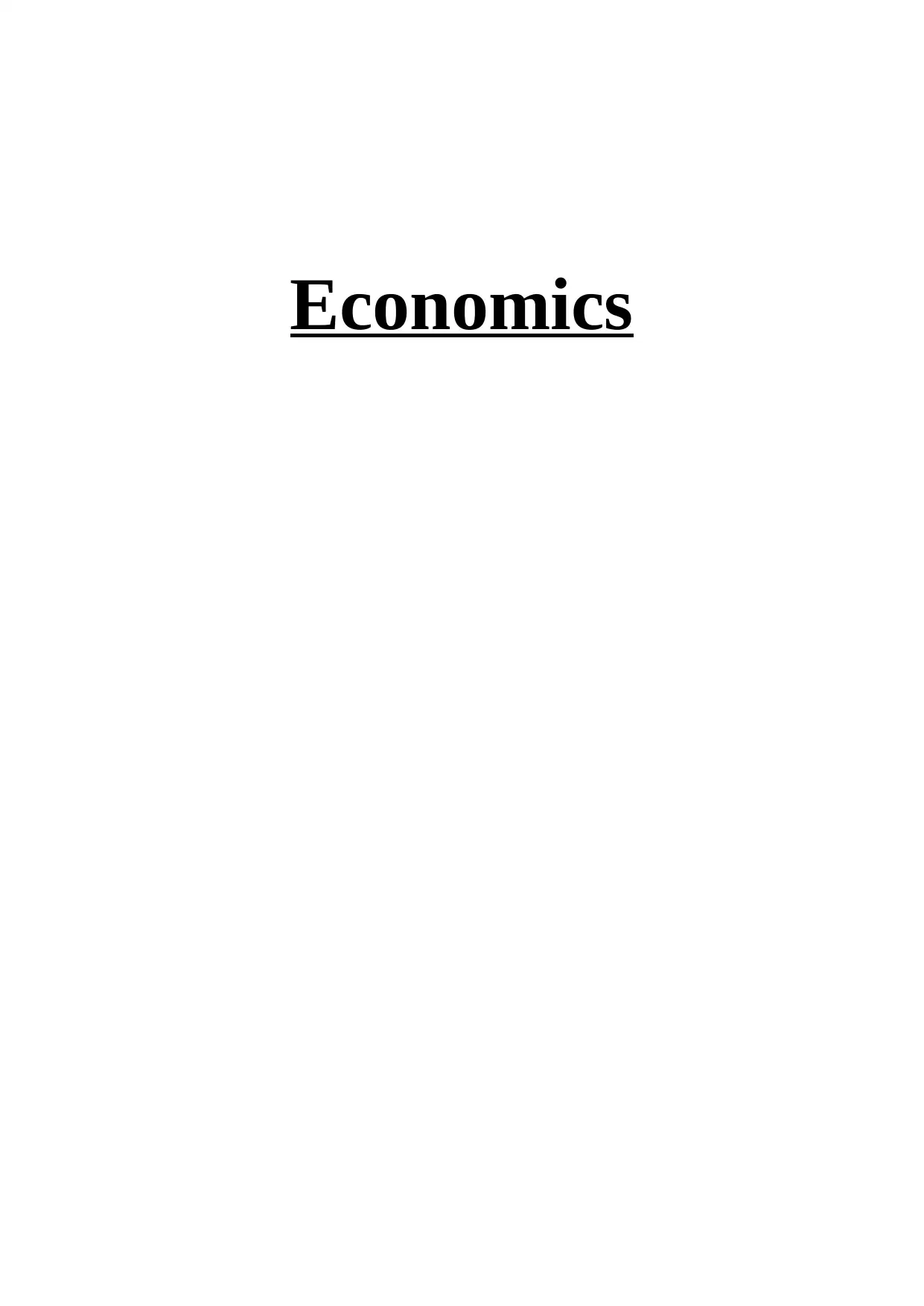
Economics
Paraphrase This Document
Need a fresh take? Get an instant paraphrase of this document with our AI Paraphraser
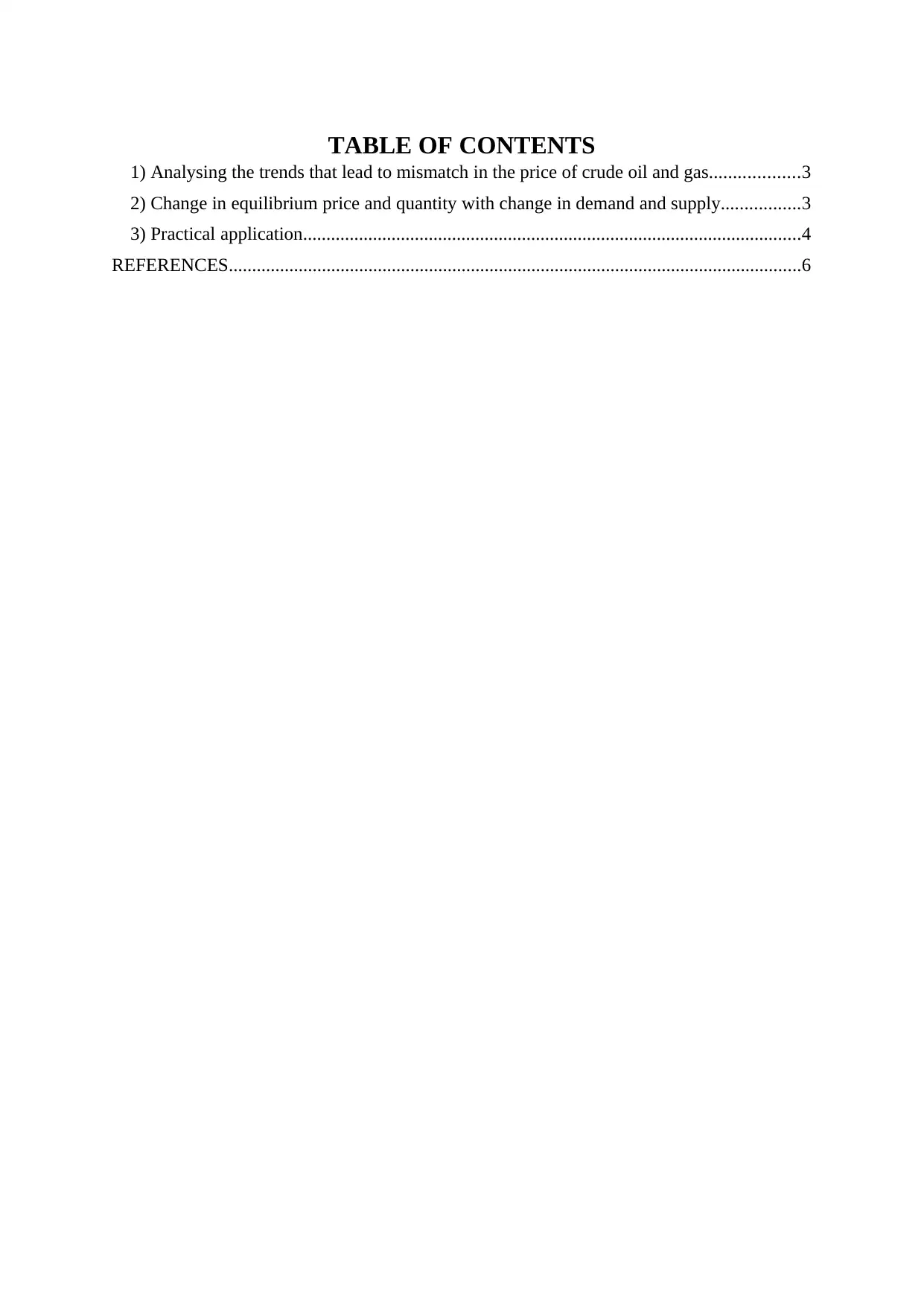
TABLE OF CONTENTS
1) Analysing the trends that lead to mismatch in the price of crude oil and gas...................3
2) Change in equilibrium price and quantity with change in demand and supply.................3
3) Practical application...........................................................................................................4
REFERENCES...........................................................................................................................6
1) Analysing the trends that lead to mismatch in the price of crude oil and gas...................3
2) Change in equilibrium price and quantity with change in demand and supply.................3
3) Practical application...........................................................................................................4
REFERENCES...........................................................................................................................6
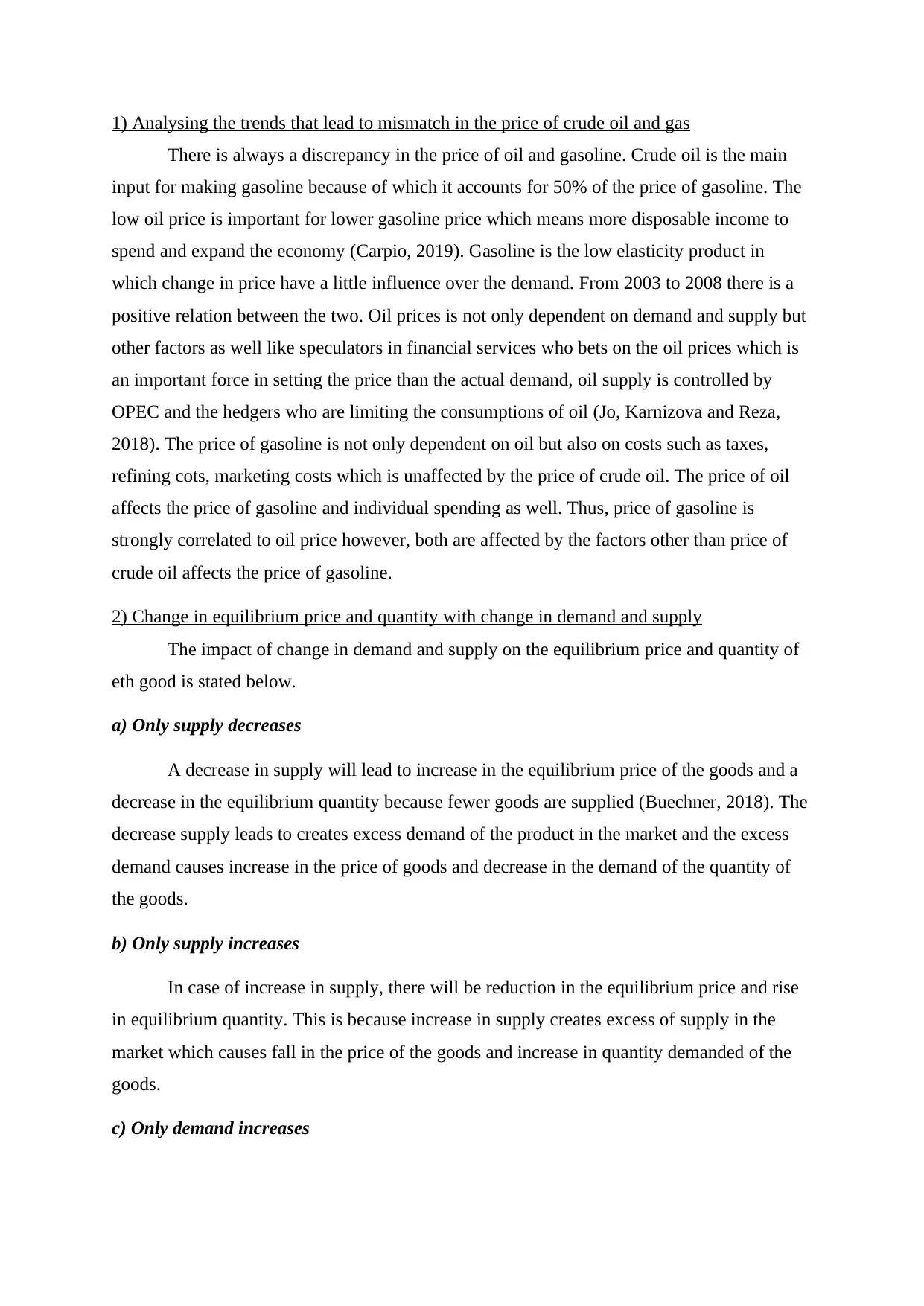
1) Analysing the trends that lead to mismatch in the price of crude oil and gas
There is always a discrepancy in the price of oil and gasoline. Crude oil is the main
input for making gasoline because of which it accounts for 50% of the price of gasoline. The
low oil price is important for lower gasoline price which means more disposable income to
spend and expand the economy (Carpio, 2019). Gasoline is the low elasticity product in
which change in price have a little influence over the demand. From 2003 to 2008 there is a
positive relation between the two. Oil prices is not only dependent on demand and supply but
other factors as well like speculators in financial services who bets on the oil prices which is
an important force in setting the price than the actual demand, oil supply is controlled by
OPEC and the hedgers who are limiting the consumptions of oil (Jo, Karnizova and Reza,
2018). The price of gasoline is not only dependent on oil but also on costs such as taxes,
refining cots, marketing costs which is unaffected by the price of crude oil. The price of oil
affects the price of gasoline and individual spending as well. Thus, price of gasoline is
strongly correlated to oil price however, both are affected by the factors other than price of
crude oil affects the price of gasoline.
2) Change in equilibrium price and quantity with change in demand and supply
The impact of change in demand and supply on the equilibrium price and quantity of
eth good is stated below.
a) Only supply decreases
A decrease in supply will lead to increase in the equilibrium price of the goods and a
decrease in the equilibrium quantity because fewer goods are supplied (Buechner, 2018). The
decrease supply leads to creates excess demand of the product in the market and the excess
demand causes increase in the price of goods and decrease in the demand of the quantity of
the goods.
b) Only supply increases
In case of increase in supply, there will be reduction in the equilibrium price and rise
in equilibrium quantity. This is because increase in supply creates excess of supply in the
market which causes fall in the price of the goods and increase in quantity demanded of the
goods.
c) Only demand increases
There is always a discrepancy in the price of oil and gasoline. Crude oil is the main
input for making gasoline because of which it accounts for 50% of the price of gasoline. The
low oil price is important for lower gasoline price which means more disposable income to
spend and expand the economy (Carpio, 2019). Gasoline is the low elasticity product in
which change in price have a little influence over the demand. From 2003 to 2008 there is a
positive relation between the two. Oil prices is not only dependent on demand and supply but
other factors as well like speculators in financial services who bets on the oil prices which is
an important force in setting the price than the actual demand, oil supply is controlled by
OPEC and the hedgers who are limiting the consumptions of oil (Jo, Karnizova and Reza,
2018). The price of gasoline is not only dependent on oil but also on costs such as taxes,
refining cots, marketing costs which is unaffected by the price of crude oil. The price of oil
affects the price of gasoline and individual spending as well. Thus, price of gasoline is
strongly correlated to oil price however, both are affected by the factors other than price of
crude oil affects the price of gasoline.
2) Change in equilibrium price and quantity with change in demand and supply
The impact of change in demand and supply on the equilibrium price and quantity of
eth good is stated below.
a) Only supply decreases
A decrease in supply will lead to increase in the equilibrium price of the goods and a
decrease in the equilibrium quantity because fewer goods are supplied (Buechner, 2018). The
decrease supply leads to creates excess demand of the product in the market and the excess
demand causes increase in the price of goods and decrease in the demand of the quantity of
the goods.
b) Only supply increases
In case of increase in supply, there will be reduction in the equilibrium price and rise
in equilibrium quantity. This is because increase in supply creates excess of supply in the
market which causes fall in the price of the goods and increase in quantity demanded of the
goods.
c) Only demand increases
⊘ This is a preview!⊘
Do you want full access?
Subscribe today to unlock all pages.

Trusted by 1+ million students worldwide
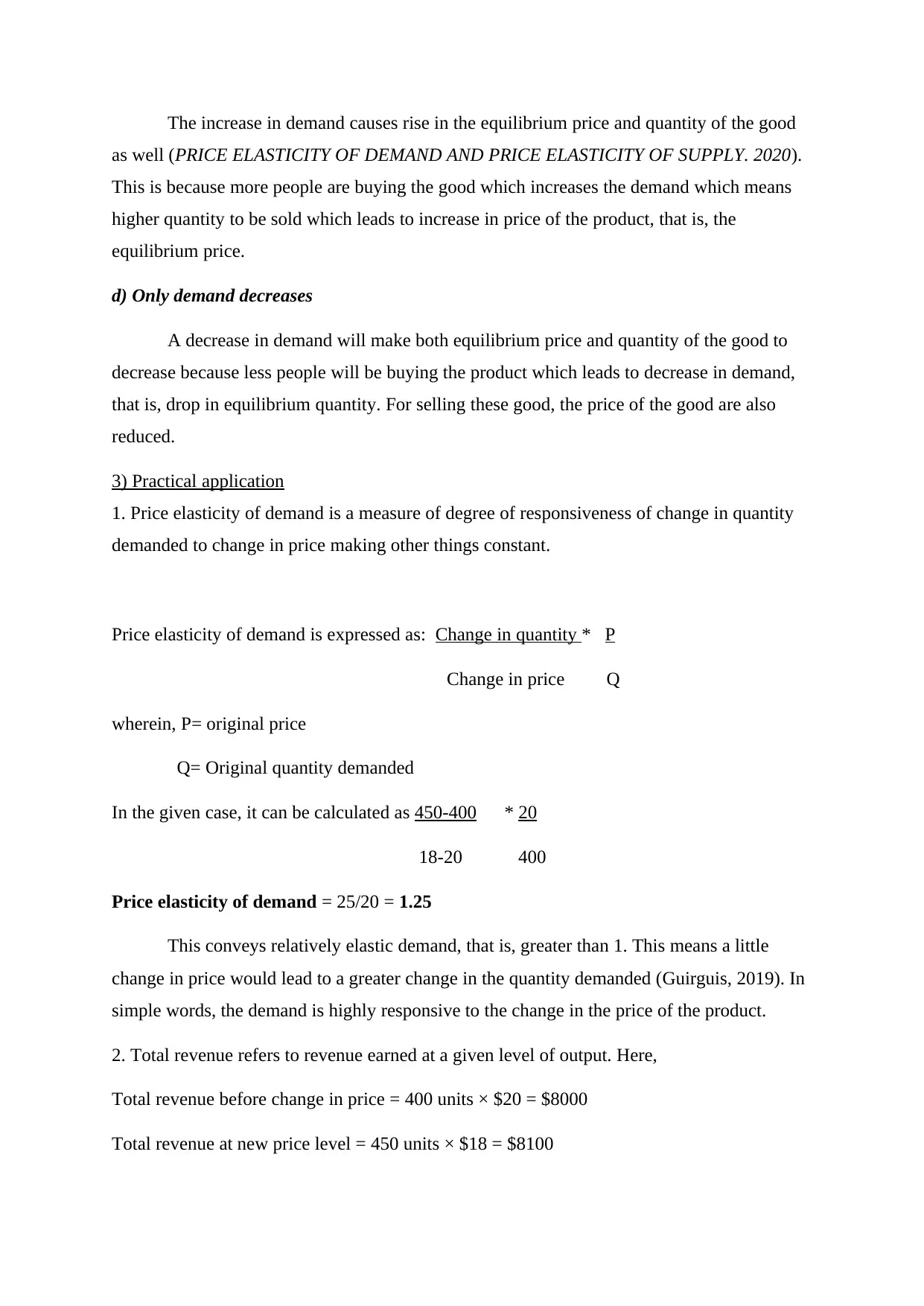
The increase in demand causes rise in the equilibrium price and quantity of the good
as well (PRICE ELASTICITY OF DEMAND AND PRICE ELASTICITY OF SUPPLY. 2020).
This is because more people are buying the good which increases the demand which means
higher quantity to be sold which leads to increase in price of the product, that is, the
equilibrium price.
d) Only demand decreases
A decrease in demand will make both equilibrium price and quantity of the good to
decrease because less people will be buying the product which leads to decrease in demand,
that is, drop in equilibrium quantity. For selling these good, the price of the good are also
reduced.
3) Practical application
1. Price elasticity of demand is a measure of degree of responsiveness of change in quantity
demanded to change in price making other things constant.
Price elasticity of demand is expressed as: Change in quantity * P
Change in price Q
wherein, P= original price
Q= Original quantity demanded
In the given case, it can be calculated as 450-400 * 20
18-20 400
Price elasticity of demand = 25/20 = 1.25
This conveys relatively elastic demand, that is, greater than 1. This means a little
change in price would lead to a greater change in the quantity demanded (Guirguis, 2019). In
simple words, the demand is highly responsive to the change in the price of the product.
2. Total revenue refers to revenue earned at a given level of output. Here,
Total revenue before change in price = 400 units × $20 = $8000
Total revenue at new price level = 450 units × $18 = $8100
as well (PRICE ELASTICITY OF DEMAND AND PRICE ELASTICITY OF SUPPLY. 2020).
This is because more people are buying the good which increases the demand which means
higher quantity to be sold which leads to increase in price of the product, that is, the
equilibrium price.
d) Only demand decreases
A decrease in demand will make both equilibrium price and quantity of the good to
decrease because less people will be buying the product which leads to decrease in demand,
that is, drop in equilibrium quantity. For selling these good, the price of the good are also
reduced.
3) Practical application
1. Price elasticity of demand is a measure of degree of responsiveness of change in quantity
demanded to change in price making other things constant.
Price elasticity of demand is expressed as: Change in quantity * P
Change in price Q
wherein, P= original price
Q= Original quantity demanded
In the given case, it can be calculated as 450-400 * 20
18-20 400
Price elasticity of demand = 25/20 = 1.25
This conveys relatively elastic demand, that is, greater than 1. This means a little
change in price would lead to a greater change in the quantity demanded (Guirguis, 2019). In
simple words, the demand is highly responsive to the change in the price of the product.
2. Total revenue refers to revenue earned at a given level of output. Here,
Total revenue before change in price = 400 units × $20 = $8000
Total revenue at new price level = 450 units × $18 = $8100
Paraphrase This Document
Need a fresh take? Get an instant paraphrase of this document with our AI Paraphraser
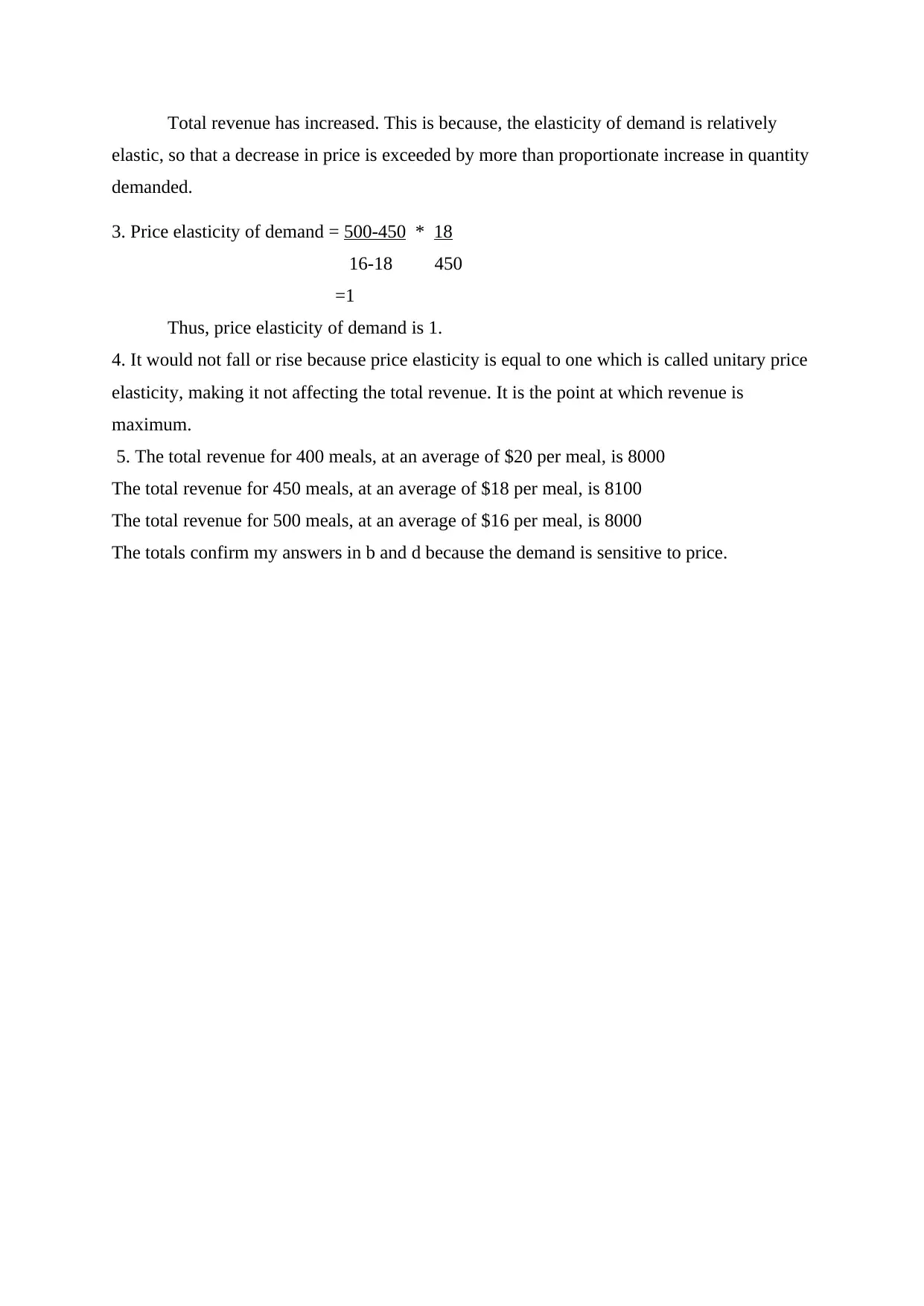
Total revenue has increased. This is because, the elasticity of demand is relatively
elastic, so that a decrease in price is exceeded by more than proportionate increase in quantity
demanded.
3. Price elasticity of demand = 500-450 * 18
16-18 450
=1
Thus, price elasticity of demand is 1.
4. It would not fall or rise because price elasticity is equal to one which is called unitary price
elasticity, making it not affecting the total revenue. It is the point at which revenue is
maximum.
5. The total revenue for 400 meals, at an average of $20 per meal, is 8000
The total revenue for 450 meals, at an average of $18 per meal, is 8100
The total revenue for 500 meals, at an average of $16 per meal, is 8000
The totals confirm my answers in b and d because the demand is sensitive to price.
elastic, so that a decrease in price is exceeded by more than proportionate increase in quantity
demanded.
3. Price elasticity of demand = 500-450 * 18
16-18 450
=1
Thus, price elasticity of demand is 1.
4. It would not fall or rise because price elasticity is equal to one which is called unitary price
elasticity, making it not affecting the total revenue. It is the point at which revenue is
maximum.
5. The total revenue for 400 meals, at an average of $20 per meal, is 8000
The total revenue for 450 meals, at an average of $18 per meal, is 8100
The total revenue for 500 meals, at an average of $16 per meal, is 8000
The totals confirm my answers in b and d because the demand is sensitive to price.
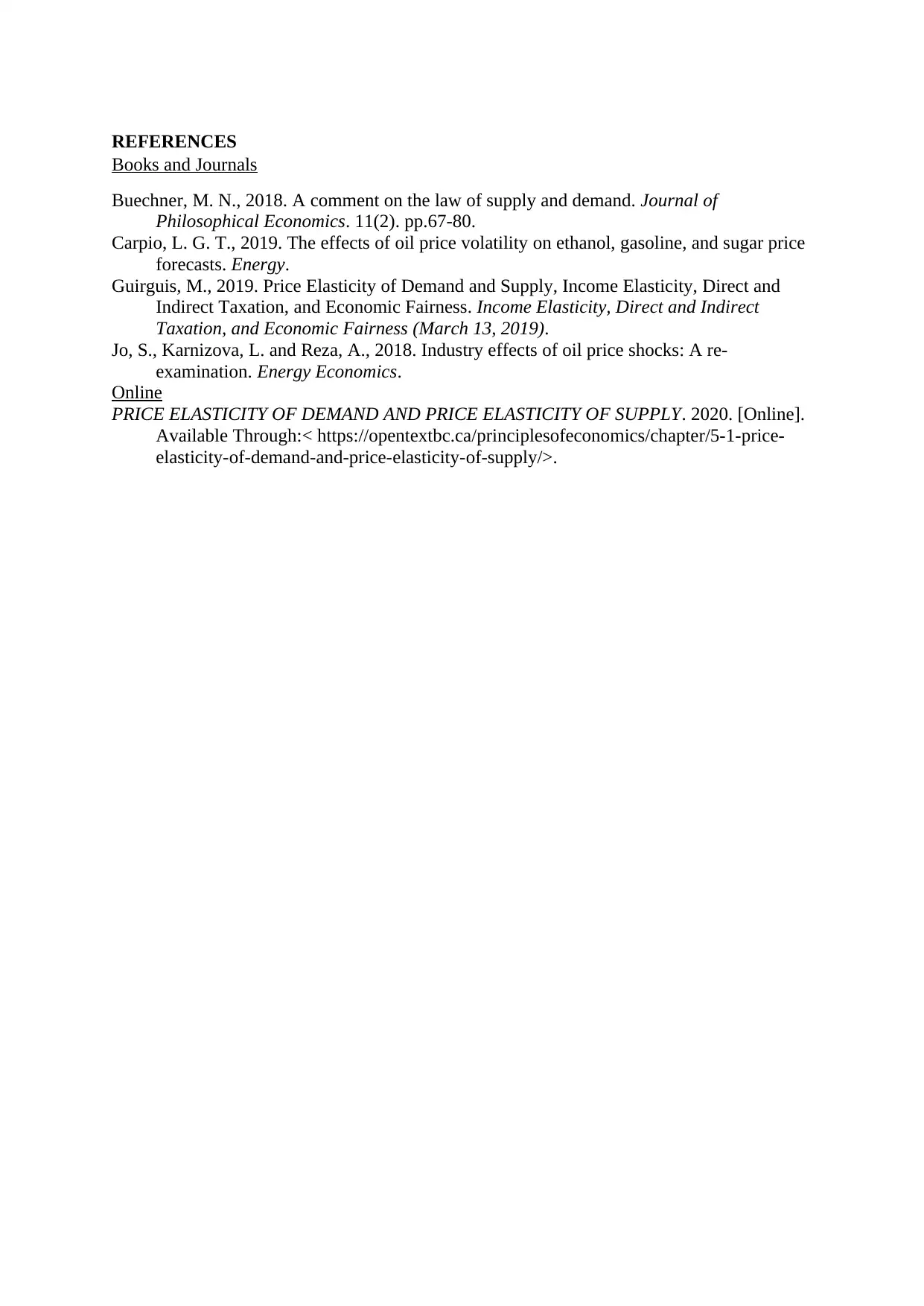
REFERENCES
Books and Journals
Buechner, M. N., 2018. A comment on the law of supply and demand. Journal of
Philosophical Economics. 11(2). pp.67-80.
Carpio, L. G. T., 2019. The effects of oil price volatility on ethanol, gasoline, and sugar price
forecasts. Energy.
Guirguis, M., 2019. Price Elasticity of Demand and Supply, Income Elasticity, Direct and
Indirect Taxation, and Economic Fairness. Income Elasticity, Direct and Indirect
Taxation, and Economic Fairness (March 13, 2019).
Jo, S., Karnizova, L. and Reza, A., 2018. Industry effects of oil price shocks: A re-
examination. Energy Economics.
Online
PRICE ELASTICITY OF DEMAND AND PRICE ELASTICITY OF SUPPLY. 2020. [Online].
Available Through:< https://opentextbc.ca/principlesofeconomics/chapter/5-1-price-
elasticity-of-demand-and-price-elasticity-of-supply/>.
Books and Journals
Buechner, M. N., 2018. A comment on the law of supply and demand. Journal of
Philosophical Economics. 11(2). pp.67-80.
Carpio, L. G. T., 2019. The effects of oil price volatility on ethanol, gasoline, and sugar price
forecasts. Energy.
Guirguis, M., 2019. Price Elasticity of Demand and Supply, Income Elasticity, Direct and
Indirect Taxation, and Economic Fairness. Income Elasticity, Direct and Indirect
Taxation, and Economic Fairness (March 13, 2019).
Jo, S., Karnizova, L. and Reza, A., 2018. Industry effects of oil price shocks: A re-
examination. Energy Economics.
Online
PRICE ELASTICITY OF DEMAND AND PRICE ELASTICITY OF SUPPLY. 2020. [Online].
Available Through:< https://opentextbc.ca/principlesofeconomics/chapter/5-1-price-
elasticity-of-demand-and-price-elasticity-of-supply/>.
⊘ This is a preview!⊘
Do you want full access?
Subscribe today to unlock all pages.

Trusted by 1+ million students worldwide
1 out of 6
Related Documents
Your All-in-One AI-Powered Toolkit for Academic Success.
+13062052269
info@desklib.com
Available 24*7 on WhatsApp / Email
![[object Object]](/_next/static/media/star-bottom.7253800d.svg)
Unlock your academic potential
Copyright © 2020–2025 A2Z Services. All Rights Reserved. Developed and managed by ZUCOL.




